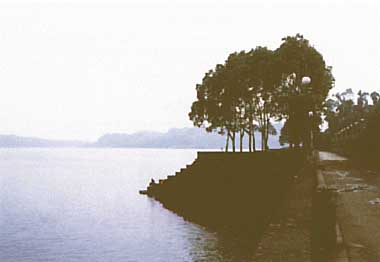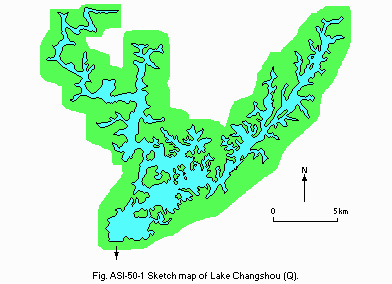CHANGSHOU-HU (LAKE CHANGSHOU)
A view on the lakeshore

Photo: Sichuan Environmental Protection Committee
A. LOCATION
- Sichuan Province, P.R. China.
- 29:56-30:12N, 107:12-107:24E; 338.15 m above sea level.
B. DESCRIPTION
Changshou-hu (Lake Changshou) is a man-made lake with another name Shizitun (Lion Beach) Reservoir. For generating electric power, four hydraulic power stations were built after damming in the 1950's. Since then a state farm was set up for fishery and horticulture as well as animal husbandry. The irrigation area amounts to 24,800 hectares (Q).
C. PHYSICAL DIMENSIONS (Q)
| Surface area [km2] | 60 |
| Volume [km3] | 0.745 |
| Maximum depth [m] | 34 |
| Catchment area [km2] | 3,020 |
D. PHYSIOGRAPHIC FEATURES
D1 GEOGRAPHICAL
- Sketch map: Fig. ASI-50-01.
- Names of main islands: Rentoushan, Anzizhai and Guofenzhai.
- Number of outflowing rivers and channels (name): 1 (Longxi R.).

Fig. ASI-50-01
Sketch map of the lake (Q).
D2 CLIMATIC
- Climatic data at Yuanjiaping, 1962-1980
| Mean temp. [deg C] |
| Jan | Feb | Mar | Apr | May | Jun | Jul | Aug | Sep | Oct | Nov | Dec | Ann. |
|---|
| 6.7 | 8.3 | 12.8 | 17.7 | 21.5 | 24.3 | 28.2 | 28.2 | 23.3 | 18.2 | 13.1 | 8.6 | 17.6 |
| Precipitation [mm] |
| Dec-Jan-Feb | Mar-Apr-May | Jun-Jul-Aug | Sep-Oct-Nov | Ann. |
|---|
| 67 | 362 | 436 | 332 | 1198 |
- Number of hours of bright sunshine: 1,190 hr yr-1.
- Water temperature [deg C]
| Dam, 1965-1977 |
| Depth [m] | Jan | Feb | Mar | Apr | May | Jun | Jul | Aug | Sep | Oct | Nov | Dec |
|---|
| S*1 | 11.8 | 11.1 | 14.1 | 19.3 | 24.1 | 26.6 | 30.7 | 31.4 | 27.2 | 22.9 | 19.4 | 15.1 |
| 10 | 12.1 | 10.7 | 11.5 | 13.4 | 17.4 | 21.2 | 24.5 | 26.4 | 25.7 | 22.8 | 19.4 | 15.3 |
| 20 | 12.0 | 10.4 | 10.8 | 12.1 | 13.1 | 16.2 | 19.1 | 20.9 | 21.9 | 21.1 | 19.3 | 15.3 |
| B*2 | 11.8 | 10.3 | 10.6 | 10.4 | 12.4 | 12.8 | 14.0 | 14.5 | 14.2 | 14.4 | 14.3 | 14.2 |
*1 Surface. *2 Bottom.
E. LAKE WATER QUALITY
E1 TRANSPARENCY [m]
| Power Plant, November-December 1981 |
| Depth [m] | Jan | Feb | Mar | Apr | May | Jun | Jul | Aug | Sep | Oct | Nov-Dec |
|---|
| - | - | - | - | - | - | - | - | - | - | 2.10 |
E2 pH
| Power Plant, November-December 1981 |
| Depth [m] | Jan | Feb | Mar | Apr | May | Jun | Jul | Aug | Sep | Oct | Nov-Dec |
|---|
| S* | - | - | - | - | - | - | - | - | - | - | 8.12 |
* Surface.
E3 SS [mg l-1]
| Power Plant, November-December 1981 |
| Depth [m] | Jan | Feb | Mar | Apr | May | Jun | Jul | Aug | Sep | Oct | Nov-Dec |
|---|
| S* | - | - | - | - | - | - | - | - | - | - | 1.9 |
* Surface.
E4 DO [mg l-1]
| Power Plant, November-December 1981 |
| Depth [m] | Jan | Feb | Mar | Apr | May | Jun | Jul | Aug | Sep | Oct | Nov-Dec |
|---|
| S* | - | - | - | - | - | - | - | - | - | - | 6.75 |
* Surface.
E5 COD [mg l-1]
Determined by KMnO4 method.
| Power Plant, November-December 1981 |
| Depth [m] | Jan | Feb | Mar | Apr | May | Jun | Jul | Aug | Sep | Oct | Nov-Dec |
|---|
| S* | - | - | - | - | - | - | - | - | - | - | 2.8 |
* Surface.
E7 NITROGEN CONCENTRATION
| Power Plant, November-December 1981 |
| Depth [m] | Jan | Feb | Mar | Apr | May | Jun | Jul | Aug | Sep | Oct | Nov-Dec |
|---|
| S* | - | - | - | - | - | - | - | - | - | - | 0.97 |
* Surface.
| Power Plant, November-December 1981 |
| Depth [m] | Jan | Feb | Mar | Apr | May | Jun | Jul | Aug | Sep | Oct | Nov-Dec |
|---|
| S | - | - | - | - | - | - | - | - | - | - | 0.015 |
| Power Plant, November-December 1981 |
| Depth [m] | Jan | Feb | Mar | Apr | May | Jun | Jul | Aug | Sep | Oct | Nov-Dec |
|---|
| S | - | - | - | - | - | - | - | - | - | - | 0.01 |
E8 PHOSPHORUS CONCENTRATION
| Power Plant, November-December 1981 |
| Depth [m] | Jan | Feb | Mar | Apr | May | Jun | Jul | Aug | Sep | Oct | Nov-Dec |
|---|
| S* | - | - | - | - | - | - | - | - | - | - | 0.001 |
* Surface.
- Supplementary notes
The difference of eight indices between surface and bottom water in December 1981.
| Flow direction -> |
| | Shidapo | Suhanghekai | Zhuzitan | Sugur Refiring | Power Plant |
|---|
| Conductivity [us l-1 cm-1] | S*1 | 335 | 260 | 270 | 275 | 275 |
| B*2 | 344 | 259 | 292 | |
| SS [mg l-1] | S | 4.1 | 309 | 4.3 | 2.5 | 1.7 |
| B | 3.3 | 4.4 | 9.2 | |
| Total hardness [deg C] | S | 7.8 | 6.3 | 6.5 | 6.6 | 6.8 |
| B | 8.2 | 6.3 | 8.1 | |
| Chromaticity [degree] | S | 25 | 10 | 13 | 13 | 10 |
| B | 30 | 15 | 15.5 | |
| NH4-N [mg l-1] | S | 0.75 | 0.03 | 0.04 | 0.03 | 0.01 |
| B | 0.94 | 0.05 | 0.12 | |
| NO2-N [mg l-1] | S | 0.21 | 0.03 | 0.01 | 0.005 | 0.014 |
| B | 0.24 | 0.04 | 0.04 | |
| NO3-N [mg l-1] | S | 0.96 | 0.54 | 0.92 | 0.94 | 0.92 |
| B | 0.84 | 0.70 | 0.70 | |
| COD [mg l-1] | S | 3.9 | 2.8 | 2.8 | 2.8 | 2.8 |
| B | 4.2 | 3.0 | 2.9 | |
*1 Surface. *2 Bottom.
F. BIOLOGICAL FEATURES (Q)
1958-1978
F1 FLORA
- Phytoplankton
Chrysophyta (Dinobryon), Xanolhonema (Tribonema), Pyrrophyta (Cryptomonas, Peridinium, Chroomonas, Ceratium), Euglenophyta (Euglena, Phacus), Chlorophyta (Chlamydomonas, Tetraedron, Ankistrodesmus, Crucigenia, Scenedesmus, Eudorina, Cosmarium, Staurastrum, Pediastrum, Treubaria, Chlorella, Coelastrum), Cyanophyta (Dactyloroccopsis, Anabaenopsis, Chroococcus), Bacillariophyta (Cyclotella, Synedra, Navicula, Melosira).
F2 FAUNA
- Zooplankton
Protozoa (Cucurbitella, Difflugia, Centropyxis, Pseudodifflugia, Actinosphaerium, Acanthocystis, Askenasia, Vorticella, Bursella, Paradileptus, Strombidium, Strobilidium, Tintinnidium, Tintinnopsis, Carchesium), Rotatoria (Brachionus, Asplanchna, Lecana, Pompholyn, Filinia, Trichocerca, Diurella, Polyarthra, Pedulia), Cladocera (Diaphanosoma, Bosmina, Daphnia, Bosminopsis), Copepoda (Eodlaptomus, Neodiaptomus, Mesocyclops, Thermocyclops, Canthocunmptus).
- fish
Cyprinus carpio, Carassius auratus, Procypris rabaudi, Hypophthalmichthys molitrix*, Aristichthys nobilis*, Mylopharyngodon idella, Ctenopharyngodon idella*, Squaliobarbus curricalus, Ochetobius elongatus, Opsariichthys uncirostris, Luciobrama macrocepriulus, Xenocypris argentea, Acanthobrama simoni, Burbodes sinensis, Varicorhinus augustistematus, Sinilabeo cendahlis, Parabramis pekinensis, Megalobrama terminalis, M. ambeyoephala, Erythroculter ileshueformis, Ancherythro culter, Culter erythropterus, Hemiculter leucisculus, H. nigromarginis, Hemibarbus maculatus, Pseudorasbora parva, Phodeus sinensis, Acheilognathus sp., Cobitis taenia, Misgurnus unguillicaudatus, Nemachilus sp., Leptobeliae longata, Sinogastromyzon seechuanensis, Hemimyzos sinensis, Parasilurus asotus, Hemibagrus macropterus, Pseudobagrus sp., Rhinogobius giurinur, Macropodus clinensis, M. operoularis, Monopterus albas, Oryzias latipes, Gambusia affinis.
* Economically important.
F5 FISHERY PRODUCTS
- Annual fish catch [metric tons]
1980: 47.
F6 PAST TRENDS
During the early period from 1956 to 1961, Hemiculter was the dominant species of fish in the reservoir. Its annual production got to 30-35 tons. Since 1962, more and more fries of Hypophthalmichthys molitrix, Aristichthys nobilis and Ctenopharygodon idella have been put into it. Hypophthalmichthys molitrix and Aristichthys nobilis have become the dominant species replacing Hemiculter since 1964.
H. LAKE UTILIZATION
H1 LAKE UTILIZATION
Source of water, navigation and transportation, and fisheries.
I. DETERIORATION OF LAKE ENVIRONMENTS AND HAZARDS
I2 TOXIC CONTAMINATION
- Present status: Detected but not serious.
- Main contaminants, their concentration and sources
| Power Plant, Nov.-Dec. 1981 |
| Name of contaminants | Range of concentration Water [ppm] |
|---|
| BHC | 0.53 |
| Hg | 0.0003 |
| Cr | 0.008 |
| Zn | 0.04 |
| Pb | 0.020 |
| Cd | 0.002 |
M. LEGISLATIVE AND INSTITUTIONAL MEASURES FOR UPGRADING LAKE ENVIRONMENTS (Q)
M2 INSTITUTIONAL MEASURES
- Chegdu Survey & Design Institute for Water Resources & Electric Power Ministry
- Sichuan Survey & Design Institute for Water Resources & Electric Power
- Zhongqing Monitoring Station for Environmental Protection
- Lake Changshou Fishery
- Hydraulic Power Plant of Lake Changshou
M3 RESEARCH INSTITUTES ENGAGED IN THE LAKE ENVIRONMENT STUDIES
- Chengdu University of Science & Technology
- Zhongqing Research Institute for Environmental Protection
- Sichuan Research Institute for Environmental Protection
N. SOURCES OF DATA
- Questionnaire filled by Sichuan Environmental Protection Committee, Chengdu, Sichuan, China.




